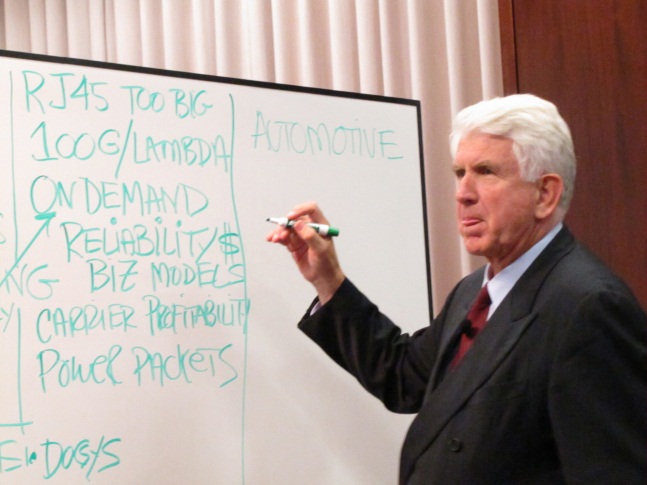Ethernet’s Future – Bright with 100% Certainty of Innovation
On October 15th and 16th the Ethernet industry gathered at the Ethernet Alliance’s Technology Exploration Forum (TEF) 2013: The Future of Ethernet. I have always looked forward to these events as I see the participants who show up to be the Ethernet Alliance’s industry Technology Advisory Board. And with Bob Metcalfe, the Father of Ethernet, keynoting the event, as well as leading an innovation panel, we had quite the time this year. From an intriguing full two-day agenda (http://ethernetalliance.org/the-future-of-ethernet-agenda/) to a packed room of industry experts and participants, there were a myriad of topics with accompanying perspectives represented at this year’s TEF to explore.
From my own personal background, I am known for my work with driving higher Ethernet speed efforts. I tend to see things from these speed-tinted glasses, but Ethernet is more than just about speeds and feeds. As Bob Metcalfe put it – Ethernet is a brand of innovation! With everything moving so quickly, there is less time to get things right and all stakeholders, from the component vendor to the system provider to the end user, ultimately need to work together. Let’s use Metcalfe’s Law to describe these consensus-building activities, where the value of our consensus building grows as a function of the number of people that gets involved. As you involve more people in such an activity, the contributed perspectives will help all to see the entirety of the problem that is faced, rather than their own perspective.
The key to Ethernet’s success has been its ability to evolve to support the needs of industry. The TEF events provide the industry with the opportunity to voice their opinions and discuss the potential evolution of Ethernet. So what opinions were voiced this year?
- The need for more speed continues unabated. As the “Next Speed” guy, I wear this target on my back, and yes, I did get asked when would we see Terabit Ethernet. The industry has reached a point where many of us just don’t see any slowdown in the exponential growth of data that we are being forced to address.
- Ethernet is the wireline background for many applications throughout the Ethernet ecosystem. While IEEE 802 wireless technology is enjoying broad market success, Ethernet is its wireline backbone, and it is important that these two technology areas continue in a synergistic fashion. Members of the wireless community are asking when 40GBASE-T will support 100m, as this would be necessary for higher efficiency / capacity wireless access points in the future. Objectives for the current IEEE 802.3bq project are only 30m targeting data center applications, so it will be interesting to see how the Ethernet community will address this need.
- Further feeding this exponential growth rate is the development and deployment of emerging applications, such as Vehicular Ethernet. I particularly enjoyed this topic, as it tied into a point that Dr. Metcalfe had made about Ethernet: build it and the applications will come. Yes, by the end of the decade we are talking about potentially 300 to 400 million ports nominally per year of Ethernet. The reality is that given the millions of cars on the road every second of every day, the potential impact on the ecosystem infrastructure is obvious. From streaming of video to making vehicles part of the Internet of Things, this influx of new users to drive consumption and creation of data will provide an additional impetus on network traffic from wireless backhaul to backbone networks to data centers.
- Cost continues to be major issue throughout the Ethernet ecosystem. It was noted how 40GbE technology is being used to enable higher density, lower cost 10GbE deployments. This is a hallmark of the Ethernet industry – finding a way to do things at lower costs.
The economic concern didn’t just apply to technology being deployed, as some were concerned that investments in new technology might be hindered due to the lack of research dollars.
- The promise of photonics integration. The panel organizer and moderator, Dale Murray of Light Counting, had an admirable angle to this session – “Go beyond the hype!” A lot of material was presented and a lot of debate between the different panelists ensued as various technologies were positioned, from silicon photonics to InP photonics to VCSELs. This panel had it all. The promise of SDN technology was such a hot topic that two separate panels were warranted. Software Defined Networking has lots of promises! It will make all hardware plain vanilla. I’m not sure how the rest of the Ethernet ecosystem feels about this. As someone who focuses on solutions at the physical layer it is not clear to me what sort of impact SDN will have on the design of the physical layer, as opposed to how it will impact how the physical layer is used.
- Collaboration between different Ethernet industry standards groups / alliances is important. Ethernet is more than just a single technology, as it runs throughout the entire ecosystem and the more aligned these groups are the better they can serve the industry.
- Innovation is alive and well! As Bob put it, he is innovating on innovation; he’s gone Meta. Perhaps it’s because he is a professor now, but putting this man in front of a white board was exciting, simply because he was so passionate about Ethernet innovation. It made all in the room think about all the opportunities available now. Bob Metcalfe certainly did and frankly I think it is safe to say he was excited by what he saw.
Don’t take my word for it. Watch Bob’s keynote speech at http://ethernetalliance.org/tef-2013-the-future-of-ethernet-keynote; find out what Bob considers to be the seven attributes of the Ethernet innovation band at http://ethernetalliance.org/tef-2013-the-future-of-ethernet-keynote.
He spoke volumes to me…Ethernet’s best days are ahead of it.
